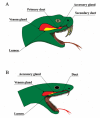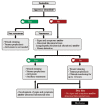Current Knowledge on Snake Dry Bites
- PMID: 33105644
- PMCID: PMC7690386
- DOI: 10.3390/toxins12110668
Current Knowledge on Snake Dry Bites
Abstract
Snake 'dry bites' are characterized by the absence of venom being injected into the victim during a snakebite incident. The dry bite mechanism and diagnosis are quite complex, and the lack of envenoming symptoms in these cases may be misinterpreted as a miraculous treatment or as proof that the bite from the perpetrating snake species is rather harmless. The circumstances of dry bites and their clinical diagnosis are not well-explored in the literature, which may lead to ambiguity amongst treating personnel about whether antivenom is indicated or not. Here, the epidemiology and recorded history of dry bites are reviewed, and the clinical knowledge on the dry bite phenomenon is presented and discussed. Finally, this review proposes a diagnostic and therapeutic protocol to assist medical care after snake dry bites, aiming to improve patient outcomes.
Keywords: antivenom; asymptomatic envenoming; dry bites; non-envenoming; snakebite; venom.
Conflict of interest statement
The authors declare no conflict of interest.
Figures




References
-
- WHO Snakebite Envenoming—Key Facts 2019. [(accessed on 22 April 2020)]; Available online: https://www.who.int/news-room/fact-sheets/detail/snakebite-envenoming.
-
- Bolon I., Durso A.M., Mesa S.B., Ray N., Alcoba G., Chappuis F., de Castañeda R.R. Identifying the snake: First scoping review on practices of communities and healthcare providers confronted with snakebite across the world. PLoS ONE. 2020;15:e0229989. doi: 10.1371/journal.pone.0229989. - DOI - PMC - PubMed
-
- Mohapatra B., Warrell D.A., Suraweera W., Bhatia P., Dhingra N., Jotkar R.M., Rodriguez P.S., Mishra K., Whitaker R., Jha P., et al. Snakebite mortality in India: A nationally representative mortality survey. PLoS Negl. Trop. Dis. 2011;5:e1018. doi: 10.1371/journal.pntd.0001018. - DOI - PMC - PubMed
Publication types
MeSH terms
Substances
Grants and funding
- 2017/03580-9/Fundação de Amparo à Pesquisa do Estado de São Paulo/International
- 2017/14035-1/Fundação de Amparo à Pesquisa do Estado de São Paulo/International
- 307155/2017- 0/Conselho Nacional de Desenvolvimento Científico e Tecnológico/International
- 302662/2017-0/Conselho Nacional de Desenvolvimento Científico e Tecnológico/International
- 00025302/Villum Foundation/International
LinkOut - more resources
Full Text Sources

